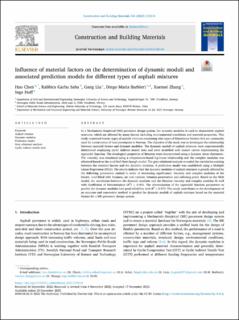| dc.contributor.author | Chen, Hao | |
| dc.contributor.author | Saba, Rabbira Garba | |
| dc.contributor.author | Liu, Gang | |
| dc.contributor.author | Barbieri, Diego Maria | |
| dc.contributor.author | Zhang, Xuemei | |
| dc.contributor.author | Hoff, Inge | |
| dc.date.accessioned | 2022-12-29T12:53:00Z | |
| dc.date.available | 2022-12-29T12:53:00Z | |
| dc.date.created | 2022-12-23T09:07:23Z | |
| dc.date.issued | 2022 | |
| dc.identifier.citation | Chen, H., Saba, R. G., Liu, G., Barbieri, D. M., Zhang, X., & Hoff, I. (2023). Influence of material factors on the determination of dynamic moduli and associated prediction models for different types of asphalt mixtures. Construction and Building Materials, 365, 130134. | en_US |
| dc.identifier.issn | 0950-0618 | |
| dc.identifier.uri | https://hdl.handle.net/11250/3039890 | |
| dc.description.abstract | In a Mechanistic-Empirical (ME) pavement design system, the dynamic modulus is used to characterise asphalt mixtures, which are affected by many factors including environmental conditions and material properties. This study examined twenty types of asphalt mixtures containing nine types of bituminous binders that are commonly used for construction of road pavements in Norway. The objective of the study was to investigate the relationship between material factors and dynamic modulus. The dynamic moduli of asphalt mixtures were experimentally determined employing cyclic indirect tensile tests and were modelled with master curves implementing the sigmoidal function. The rheological properties of bitumen were characterised using a dynamic shear rheometer. The viscosity was simulated using a temperature-based log-linear relationship and the complex modulus was obtained based on the modified Huet-Sayegh model. The grey relational analysis revealed the correlation existing between the material factors and the dynamic modulus. A prediction model was established using a Multiple Linear Regression (MLR). The results indicate that the dynamic modulus of asphalt mixtures is greatly affected by the following parameters ranked in order of decreasing significance: viscosity and complex modulus of the binder, void filled with bitumen, air void content, bitumen penetration and softening point. Based on the MLR model, the correlation between the dynamic modulus and the bitumen viscosity and complex modulus fit well with Coefficient of Determination (R2) ≥ 0.901. The determination of the sigmoidal function parameters to predict the dynamic modulus had good reliability with R2 ≥ 0.973. This study contributes to the development of an accurate and convenient method to predict the dynamic moduli of asphalt mixtures based on the material factors for a ME pavement design system. | en_US |
| dc.language.iso | eng | en_US |
| dc.publisher | Elsevier | en_US |
| dc.rights | Navngivelse 4.0 Internasjonal | * |
| dc.rights.uri | http://creativecommons.org/licenses/by/4.0/deed.no | * |
| dc.title | Influence of material factors on the determination of dynamic moduli and associated prediction models for different types of asphalt mixtures | en_US |
| dc.title.alternative | Influence of material factors on the determination of dynamic moduli and associated prediction models for different types of asphalt mixtures | en_US |
| dc.type | Peer reviewed | en_US |
| dc.type | Journal article | en_US |
| dc.description.version | publishedVersion | en_US |
| dc.rights.holder | The author | en_US |
| dc.subject.nsi | VDP::Matematikk og Naturvitenskap: 400 | en_US |
| dc.source.volume | 365 | en_US |
| dc.source.journal | Construction and Building Materials | en_US |
| dc.identifier.doi | 10.1016/j.conbuildmat.2022.130134 | |
| dc.identifier.cristin | 2097192 | |
| cristin.ispublished | true | |
| cristin.fulltext | original | |
| cristin.qualitycode | 2 | |

